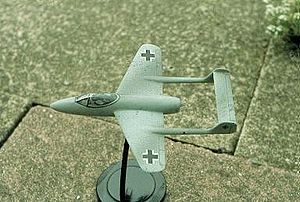Focke-Wulf Project VII Video - Picture

|
|
Focke-Wulf Project VII
Project VII Flitzer

Picture - Wartime model of the Project VII design
Role: Fighter
Manufacturer: Focke-Wulf
Status: Unfinished project
The Focke-Wulf Project VII Flitzer ("streaker" or "dasher", sometimes incorrectly translated as "madcap") was a jet fighter under development in Germany at the end of World War II. The design began as Focke-Wulf Project V which had a central fuselage and two booms carrying the rear control surfaces. This was at about the same time that the de Havilland Vampire was under development. When the Vampire was first seen in the Focke-Wulf Projects Office in 1945, there was considerable amazement at the marked similarity of the two aircraft. However, this similarity was due to nothing more than two independent development teams coming up with the same solution to a common problem. Project V had the air inlets still positioned on either side of the nose, just below the cockpit.
The estimated horizontal speed was not satisfactory and, in the next development, Project VII the jet intakes were situated in the wing roots, like the Vampire. (It is possible that two forms of intake were considered, one triangular and the other rectangular.) Further improvements over Project V were a narrower fuselage and a changed pilot's canopy. In order to improve the rate of climb, a Walter HWK 109-509 liquid rocket was built-in. In spite of the fact that a complete mock-up was built and all construction and assembly plans finished, the aircraft was not accepted by the RLM (Reich Air Ministry, or Reichsluftfahrtministerium).
Specifications (design draft of 15 September 1944)
Data from
General characteristics
Crew: one pilot
Length: 10.55 m (34 ft 7 in)
Wingspan: 8.00 m (26 ft 3 in)
Height: 2.35 m (7 ft 8 in)
Wing area: 17.0 m² (183 ft²)
Empty weight: 2,730 kg (6,018 lb)
Gross weight: 4,350 kg (9,589 lb)
Powerplant: 1 x— BMW 003 turbojet, 14.7 kN (3,306 lbf) thrust
1 x— Walter HWK 109-509 rocket, 16.7 kN (3,750 lbf) thrust
1 x— Walter HWK 109-509 rocket, 16.7 kN (3,750 lbf) thrust
Performance
Maximum speed: 955 km/h (593 mph)
Endurance: 1 hours 50 min
Service ceiling: 13,000 m (42,500 ft)
Rate of climb: 18.2 m/s (3,600 ft/min)
Armament
2 x— 30 mm (1.18 in) MK 103 cannons
2 x— 20 mm MG 151 cannons
Lens, K.; H. J. Nowarra (1964). Die Deutschen Flugzeuge. Munich: J F Lehmans Verlag.
Masters, David (1982). German Jet Genesis. London: Jane's Publishing.
Myhra, David (1998). Secret Aircraft Designs of the Third Reich. Atglen: Schiffer. pp. 141-42.
Nowarra, Heinz (1983). Die deutsche Luftrx¼stung 1933-1945. Bonn: Bernard and Graefe. pp. Teil 2, p.117.
Schick, Walter; Ingolf Meyer (1997). Luftwaffe Secret Projects: Fighters 1939-1945. Hinckley: Midland Publishing. pp. 143-44.
Smith, J. R. (1973). Focke-Wulf: An Aircraft Album. London: Ian Allan.
Smith, J. R.; A. Kay (1972). German Aircraft of the Second World War. London: Putnam.
Wagner, Wolfgang (1980). Kurt Tank: Konstruckteur und Test Pilot bei Focke-Wulf. Munich: Bernard and Graefe.
Focke-Wulf Project VII Pictures
More aircraft.
Source: WikiPedia